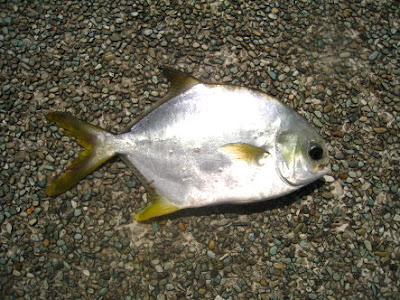Golden Pomfret or Pompano Caught at Woodland Jetty

 Golden Pomfret or Pompano also know as Kim Chio 金鲳魚 Caught at Woodland Jetty
Golden Pomfret or Pompano also know as Kim Chio 金鲳魚 Caught at Woodland JettyGolden Pomfret or Pompano [Xenobrama microlepis] also know as Kim Chio 金鲳魚 [Chinese] or Bawal mas kapak [Malay] They average between 500gm to 1kg in size and have no teeth. They are beautifully colored with a slightly yellow under belly. Golden Pomfret or Pompano [Xenobrama microlepis] also know as Kim Chio 金鲳魚 [Chinese] or Bawal mas kapak [Malay] are bottom feeders. They eat the small shell crustations that inhabit the sand bottoms or prawn meat and sometime they eat bread mean for mullet.
Ideal Conditions for fishing Golden Pomfret or Pompano [Xenobrama microlepis] also know as Kim Chio 金鲳魚 [Chinese] or Bawal mas kapak [Malay] are last 2 hours of a rising tide are best, and the first hour of a falling tide can be good. The surf should be heavy-light to light-medium so as to stir up the sand fleas. White caps are probably too much surf. A calm or light wind is usually present in these conditions. The water should be somewhat clear and its temperature should be at or above 65 degrees F. A steady and/or rising barometer is ideal.
Golden Pomfret or Pompano [Xenobrama microlepis] also know as Kim Chio 金鲳魚 [Chinese] or Bawal mas kapak [Malay] usually feed on the beach side of the outer sand bars during the incoming tide. Wade out as far as possible (waist deep) and cast from there. Have extras sand fleas, prawn meat or bread in your bait pouch so that if the hook needs to be re-baited it can be done while in the surf. A reef can be an excellent spot to find them and the rocks provide a great platform to stand on while fishing.
Labels: Bawal mas kapak, Fishing Hotspots, Golden Pomfret, Kim Chio, Pancing, Pompano, Woodland Jetty, Xenobrama microlepis, 金鲳魚, 钓鱼


3 Comments:
Hi, I don't think this is a Golden Pomfret but a Snub-nosed Dart, as it is known in Australia or a Permit in America.(Trachinotus blochii). It is in the same family as Trevally and Queenfish.
I regularly read your reports, keep up to good work.
http://speciesfishing.blogspot.com/
By puffinbytes, At
January 31, 2012 at 12:56 PM
puffinbytes, At
January 31, 2012 at 12:56 PM
Golden Pomfret or Pompano are bred in singapore refer to this link: http://www.straitstimes.com/BreakingNews/Singapore/Story/STIStory_740067.html
By Andy Lim, At
February 4, 2012 at 5:57 AM
Andy Lim, At
February 4, 2012 at 5:57 AM
I see the problem now. The fish in the photo in that link is also a member of the genus Trachinotus. The Golden Pomfret or Golden Pompano seems to be the local name for what I call a snub nosed dart.
The scientific name you had is incorrect. It is defnitely not Xenobrama microlepis
http://www.fishbase.org/summary/Xenobrama-microlepis.html
If you look at the dorsal fin in the picture in this link, it starts directly above the pectoral fins. In your fish the dorsal fin starts further back torwards the back of the body. More similar to http://www.fishbase.org/summary/Trachinotus-blochii.html
Xenobrama microlepis is also a deepsea fish that only occurs around new zealand. If you look at photos of other fish in that family you will see what I mean:
http://www.fishbase.org/identification/specieslist.php?famcode=319&areacode=
Cheers
By puffinbytes, At
February 5, 2012 at 3:01 AM
puffinbytes, At
February 5, 2012 at 3:01 AM
Post a Comment
Subscribe to Post Comments [Atom]
<< Home